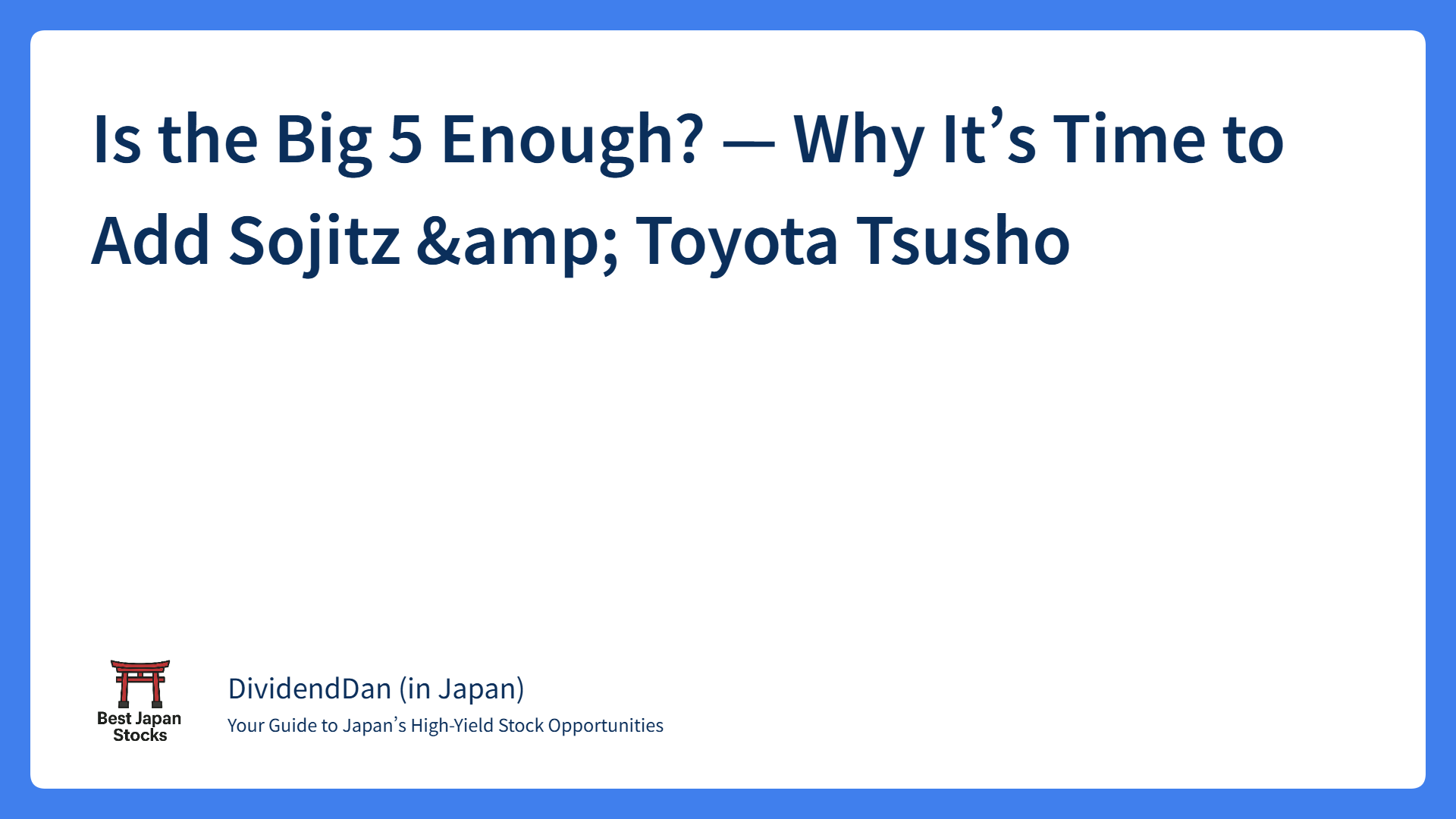Why Did Warren Buffett Quietly Place a Massive Bet on Japan’s Big Five Trading Houses? — A Deep Dive into His ‘Mini-Berkshire’ Insight and Multi-Layered Return Design —
0. How to Read This Article
| What you want to learn | Section | Content |
|---|---|---|
| Big picture | 1 | How Berkshire’s stake grew (2019-25) and its market impact |
| The shōsha model | 2 | Mechanics of Japan’s unique general-trading companies |
| The numbers | 3 | Side-by-side PBR, ROE, dividend yields, overseas sales ratio |
| Strategic logic | 4 | Analysis from diversification, cash-flow and FX angles |
| Company snapshots | 5 | Strengths, risks and upcoming catalysts for all five firms |
| Action steps | 6 | A quick checklist for investors |
1. Introduction: Buffett’s Rare Public Bet on Japan
1.1 A Quiet Buying Spree (Jul 2019 – Aug 2020)
- July 2019 – Berkshire begins quietly buying the five trading houses on the Tokyo market.
- It caps daily purchases at roughly 3–5 % of average turnover, a “base-trading” tactic that keeps prices stable.
- 28 Aug 2020 – Berkshire discloses 5 %+ stakes in all five companies; share prices surge 7–13 % the next day, handing Berkshire an estimated ¥730 bn paper gain. reuters.com
1.2 Commitment Deepens (Jan 2021 – Mar 2025)
| Date | Itochu | Marubeni | Mitsubishi | Mitsui | Sumitomo | Note |
|---|---|---|---|---|---|---|
| Aug 2020 | 5.02 % | 5.06 % | 5.04 % | 5.06 % | 5.03 % | Initial filing |
| Apr 2022 | 6.79 | 6.75 | 6.84 | 6.62 | 6.60 | “<10 %” ceiling declared |
| Nov 2023 | 8.02 | 8.21 | 8.40 | 8.37 | 8.12 | Samurai-bond issue #3 |
| Mar 2025 | 9.25 | 8.53 | 9.67 | 9.82 | 9.29 | Firms lift the ≤10 % cap |
- Berkshire’s self-imposed “under-10 %” limit is now waived with each company’s approval, giving room for further buying. reuters.com
- A foreign corporation could become the No. 1 shareholder on multiple Japanese share registers for the first time. reuters.com
1.3 Three Questions Investors Ask
- Why Japan? Why stray from a U.S.-centric portfolio?
- Why sōgō shōsha? How does Buffett value a structure found nowhere else?
- Why now? What top-down view made 2020-25 the moment to strike?
We answer these through the lenses of business model × financial metrics × macro tailwinds.
2. Japan’s Five General-Trading Giants
2.1 Sōgō Shōsha: A Conglomerate Found Only in Japan
Functions include global trading, large-scale project finance, equity investments, logistics, and full-spectrum risk management. edamamejapan.com
Typical profit formula
Operating profit = Commercial trading margin
+ Equity-method earnings
+ Dividends / interest income
Operating cash-flow = Trading cash + Dividends + Loan repayments
- >60 % of income originates overseas, providing an embedded FX hedge. itochu.co.jp
- Highly diversified across resources, consumer goods, infrastructure and services—“a small economy inside one ticker.”
2.2 Portfolio Mix and Edge
| Company | Resources | Non-resources | Overseas | Quick take |
|---|---|---|---|---|
| Itochu | 25 % | 75 % (food, apparel, retail) | 65 % | Consumer-centric, defensive |
| Marubeni | 35 | 65 (agri, renewables) | 68 | Turnaround, agri differentiation |
| Mitsubishi | 50 | 50 | 62 | World-scale LNG & metals |
| Mitsui | 45 | 55 (healthcare, IT) | 66 | Metals + healthcare twin engines |
| Sumitomo | 30 | 70 (infra, real estate) | 61 | Steady infra-heavy model |
Key theme: Diversification + global reach + cash-flow power = “Mini Berkshire.” morningstar.com
3. The Numbers Buffett Cares About
3.1 Buffett’s Four Checkpoints
- Value – low PBR, attractive P/E
- Quality – double-digit ROE/ROIC, stable cash generation
- Shareholder-first – dividends + buybacks > 5 %
- Moat & Management – resource entitlements, global brands, capital-efficiency mindset
3.2 Key Metrics (FY Mar-2025 company guidance)
| PBR | PER | ROE | Div. Yield | Total Payout* | Net D/E | Op-CF / Sales | Overseas % | |
|---|---|---|---|---|---|---|---|---|
| Itochu | 1.3 | 11.7 | 14.5 | 3.8 | 6.4 | 0.72 | 4.9 % | 65 |
| Marubeni | 0.9 | 9.2 | 13.2 | 4.4 | 7.1 | 0.69 | 5.3 % | 68 |
| Mitsubishi | 1.0 | 9.4 | 13.8 | 4.0 | 6.0 | 0.48 | 6.1 % | 62 |
| Mitsui | 1.1 | 9.7 | 15.1 | 4.2 | 6.5 | 0.55 | 5.6 % | 66 |
| Sumitomo | 0.8 | 10.1 | 11.7 | 4.8 | 7.4 | 0.66 | 5.0 % | 61 |
*Dividends + buybacks ÷ market cap.
3.3 Reading the Numbers
- Low PBR + double-digit ROE = profitable yet undervalued. reuters.com
- Total payout 6–7 % beats the 10-year JGB by ~250 bp. morningstar.com
- Net D/E < 0.8 leaves capacity for both reinvestment and higher buybacks.
The Tokyo Stock Exchange’s push for sub-1× PBR firms to raise capital efficiency further turbo-charges this trend. sparx.co.jpjpx.co.jp
4. Three Strategic Reasons Behind Buffett’s Bet
4.1 “Mini-Berkshire” Diversification
Berkshire itself spreads across insurance, railroads, energy and retail; the shōsha mirror that mosaic in resources, consumer goods, finance and infrastructure, with roughly 60 % of profit sourced abroad—buy one stock, get a portfolio. reuters.comm.economictimes.com
4.2 Cash Flow + Governance Tailwinds
ROE for listed Japanese firms jumped from 8 % to 12 % in less than a decade, driven by governance reforms and TSE pressure; trading houses have led the buyback wave. reuters.comsparx.co.jp
4.3 Yen Carry Trade via Samurai Bonds
- Berkshire has issued about ¥1.6 trn in low-coupon samurai bonds since 2019, most recently at ~0.5 % yield. businessinsider.comainvest.com
- It funnels cheap yen into equities yielding 4-5 %, pocketing dividends plus any yen weakness versus the dollar. barrons.comm.economictimes.com
In short: FX, rate and dividend spreads combine into a three-layer carry trade.
5. Company-by-Company Highlights
| Itochu | Marubeni | Mitsubishi | Mitsui | Sumitomo | |
|---|---|---|---|---|---|
| Investment angle | 75 % non-resources → steady cash | Agri & renewables unlock rerate | Largest scale, LNG leverage | Metals × Healthcare growth mix | Infra/real-estate yield anchor |
| Next catalyst | Convenience-store DX, textile reuse | Grain–Agri-Food (GAF) strategy | Extra ¥ 1 tn buyback frame | Digital-health platform rollout | Manila Metro rail operations start |
| Key risk | Post-COVID consumer swings | Crop-price volatility, deleveraging | Commodity price swings | Metal cycle + new-biz execution | Long-tail infra payback |
reuters.comdividendjapan.substack.com
6. Action Checklist for Investors
- Dividend & buyback calendar – check ex-dates (e.g., Mitsubishi late Mar, Mitsui Mar 31).
- FX sensitivity – un-hedged yen exposure can amplify USD returns when the yen weakens.
- Yield gap vs. Treasuries – maintain a ≥ 2 % spread to justify holding.
- Resource cycle – tilt toward non-resource-heavy names if commodities peak.
- Monitor ROE targets – each mid-term plan update signals future payouts.
7. Conclusion: One-Stop Value, Income and Diversification
Low-PBR, high-ROE, high-payout shōsha let investors capture sector-wide diversification in a single ticker, with macro tailwinds from yen weakness and still-low Japanese rates. Buffett’s room to add further stakes keeps the spotlight on this uniquely Japanese opportunity—and on the disciplined financial engineering behind his “quiet, giant wager.”
Note: All factual statements are sourced from public filings and reputable news outlets. See inline citations for details; figures are as of March 2025 unless noted otherwise.


